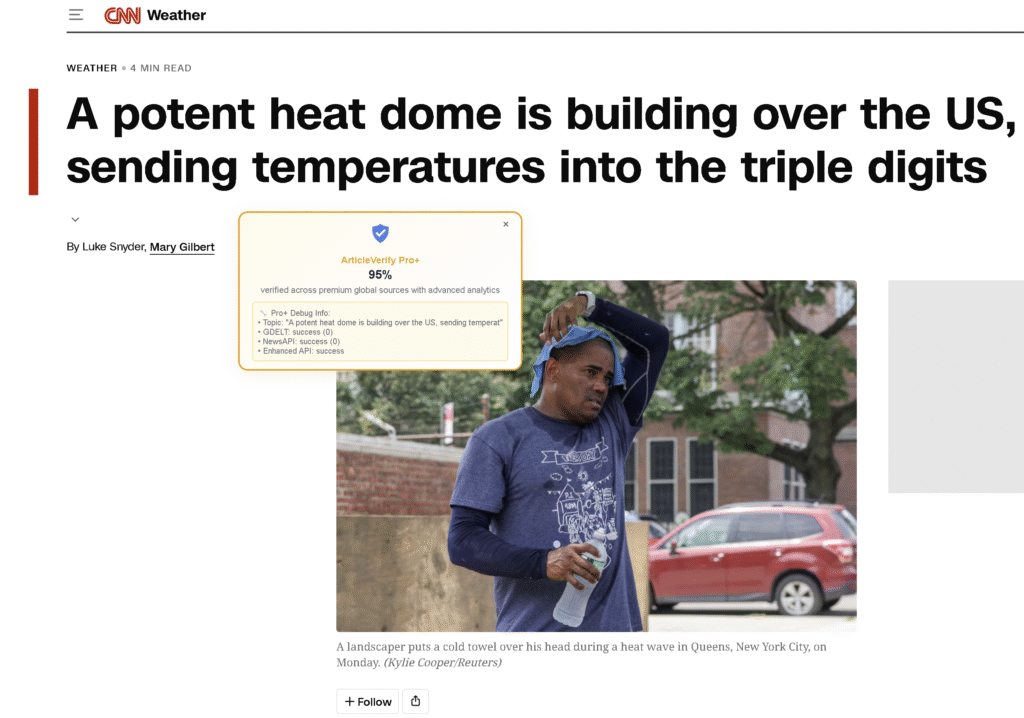

AI Technology and Credibility Methodology
Our AI-Powered Analysis Engine
ArticleVerify employs advanced natural language processing (NLP) and machine learning algorithms to evaluate news article credibility in real-time. Our proprietary AI system analyzes multiple linguistic and contextual factors within each article, including writing style consistency, factual claim density, source attribution patterns, and emotional language indicators. The AI model has been trained on thousands of verified news articles from reputable sources, learning to identify the subtle patterns that distinguish credible journalism from misleading content.
Our machine learning pipeline incorporates sentiment analysis, named entity recognition, and fact-pattern matching to create a comprehensive credibility assessment. The AI examines structural elements such as headline-to-content alignment, quote authenticity markers, and statistical claim substantiation. Additionally, our system evaluates the logical flow of arguments, identifies potential bias indicators, and assesses the presence of verifiable facts versus opinion-based statements.
Multi-Source Global Verification Process
Beyond AI analysis, ArticleVerify’s Pro and Pro+ tiers employ a sophisticated cross-referencing methodology that validates article claims against multiple international news databases. Our system automatically extracts key topics and claims from the article being analyzed, then searches through the Global Database of Events, Language, and Tone (GDELT), NewsAPI’s extensive archive, and MediaStack’s real-time news feeds to find corroborating coverage.
The verification process assigns weighted scores based on source diversity, geographical coverage, and temporal consistency of reporting. When multiple reputable international sources cover the same story with consistent facts, the credibility score increases significantly. Conversely, if an article makes claims that cannot be found in our global news network, or if coverage is limited to questionable sources, the score reflects this lack of verification.
Enhanced Analytics for Pro+ Users
Pro+ subscribers benefit from our most advanced analytical capabilities, including source diversity metrics, coverage depth analysis, and temporal fact-checking. Our enhanced system evaluates not just whether a story is covered elsewhere, but how comprehensively it’s reported across different geographical regions, political perspectives, and media types. This multi-dimensional approach helps identify potential echo chambers or coordinated misinformation campaigns.
The Pro+ analytics engine also performs advanced pattern recognition to identify recurring themes, fact-check previous claims made by the same publication, and assess the historical accuracy track record of sources cited within the article. This longitudinal analysis provides users with context about both the immediate credibility of a specific article and the broader reliability patterns of its publisher.
Transparency and Continuous Improvement
Our credibility scoring methodology is designed to be transparent and continuously evolving. The AI models are regularly updated with new training data, incorporating feedback from fact-checking organizations and adjusting for emerging misinformation tactics. We maintain strict editorial independence, ensuring our algorithms evaluate content based solely on journalistic standards rather than political alignment or commercial interests. Users can always access detailed explanations of how their specific article scores were calculated, promoting media literacy and informed news consumption.
What ArticleVerify Does
1. Compel Accuracy
Making Writers be more Precise.
2. Modify Behavior
ArticleVerify forces the writer and the consumer to change the way they write and consume information.
3. Global Perspectives
Built to transcend borders by comparing articles against a diverse network of global sources.
4. Shield Against Misinformation
Validates the credibility of information.
Extension Plan Examples

Free Access – Example

Pro+ Plan – Example

Pro Plan – Example




